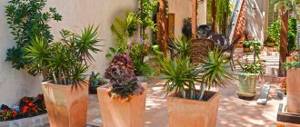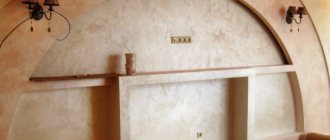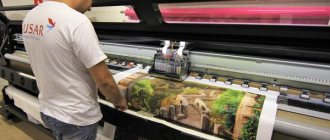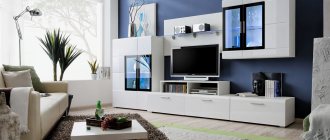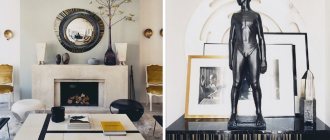There is hardly anything that decorates a room better than stained glass. The rays of the sun passing through the colored glass cast mesmerizing spots on the walls and floor. Stained glass on windows and door glass perform the function of blinds: with their help, bright sunlight is diffused and does not hit the eyes. Panels on interior doors will hide you from prying eyes and create a cozy atmosphere.
Since the 19th century, along with the Art Nouveau style, stained glass windows also came into the interior of residential buildings, firmly established themselves in it and became a method of creating a unique home design.
But the main purpose of colored glass assembled into a composition is interior decoration. In ancient times, stained glass was used only in windows. Now the boundaries of mosaic design have expanded; they decorate office premises, greenhouses, balconies, ceilings, doors, wardrobes, kitchen facades, mirrors. And if the owner has skillful hands, it is not difficult for him to create chandeliers and lamps from multi-colored pieces.
Modern technologies make it possible to make the production of stained glass windows affordable, placing them harmoniously in the interior of even a small apartment.
Advantages and disadvantages of stained glass
A decorative glass composition will attract the attention of professionals and ordinary people. Bright colors, refracted sun rays, a stylish or classic design will make you linger on the glass mosaic. However, colored panels have both advantages and disadvantages.
Stained glass windows in the interior will become a means of visually expanding the space.
Advantages of stained glass:
- Colored mosaics add an aesthetically pleasing look to indoor and outdoor spaces.
- Stained glass windows are resistant to corrosion and do not freeze.
- If the mosaic consists of separate fragments, they can be replaced if necessary.
- A bright panel installed in a window opening replaces curtains and curtains and visually increases the volume of the room.
- Mosaics do not burn or melt, that is, they are fireproof.
- This type of glazing is recognized as environmentally friendly.
- With the help of stained glass you can give an unsightly building a modern, non-standard look.
- And most importantly: a stained glass window created with your own hands emphasizes the individuality of the home and the artistic taste of the owner.
Initially, stained glass consisted of carefully selected pieces of glass connected by metal partitions.
However, decorative panels also have disadvantages. True, there are much fewer of them.
- Mosaics made with acrylic paints require special heat treatment.
- Stained glass is fragile, like any glass.
- When glazing large areas (office building), it is necessary to take into account the resistance to wind loads and the seismic activity of the area.
- Spherical mosaic shapes are not durable.
- Prefabricated stained glass windows have a low percentage of strength. For large areas it is better to use film or cast panels.
A variant of classic stained glass is called Tiffany style.
Other techniques for creating stained glass on glass
There are many technologies, but not all are suitable for doing at home. You can easily implement the above methods at home, but the ones listed here are unlikely.
Painting. This is where everything goes - a drawing is made on glass with acrylic paints, and then it is covered with acrylic varnish. True, the look is completely different. Or use silicone paints for stained glass; they are transparent, but take on color after firing.
You are also unlikely to do etching at home - this is work with acid, which is used to etch the drawing.
Cast stained glass requires tools for blowing glass and giving it a special texture.
Sintering or fusing is a technique in which pieces of glass are sintered together in a furnace. The drawings, however, turn out fuzzy, some even quite abstract. Well, of course, special ovens are also needed.
Tiffany style stained glass is also a difficult job because it requires glass cutters, tin, a soldering iron and soldering acid. In general, it’s definitely not for beginners.
Sandblasting work is done using air flow and colored sand.
Types of stained glass
To appreciate the splendor of stained glass, it is worth getting acquainted with its history.
Stained glass is a type of decorative and applied art. It was conceived as an element filling window openings. The design is designed for through lighting, that is, it makes no sense to fill a blind niche with glass decor. Art originated in Europe and was mainly used to decorate cathedrals and temples. Not only the church, but also titled persons could afford to have such wealth, decorating the windows of their castles.
Various types of stained glass differ in the complexity and cost of work and the materials used, but all of them allow you to create a unique interior.
Initially, glass mosaics were assembled from pieces of colored glass, fastening them together with lead bridges. Then the technique of scraping glass specially painted with colored paint appeared.
Performance technique
Modern stained glass has about two dozen types. In order to make stained glass windows with your own hands, you need to figure out which ones are suitable for homework. It all depends on the complexity of the materials and manufacturing techniques.
- Classic (or mosaic) stained glass has come down from the depths of centuries, practically unchanged. It is also called stacked, because during the creation process, pieces of colored glass are “set,” that is, connected, to each other with tin, lead or brass plates.
This is how stained glass was made in medieval times, and this technology is still used today.
- The pattern on glass when making etched stained glass is achieved in this way. A pattern is applied to the glass with hydrofluoric acid, which reacts to “etch” the grooves that make up the pattern in the surface.
- Fusing is another type of colored mosaic. It is based on sintering pieces of glass assembled together at a very high temperature. The second name is stained glass. In this technique, a design can be created by baking foreign elements (wire, stones) into glass.
To create it, colored glass fragments are baked; in addition, small foreign particles can be included in them - for example, pieces of wire.
- Another option is a combined panel. In this technique, the author is not constrained by standards; he can combine different types of stained glass, achieving a three-dimensional effect and expressiveness of his creation.
- When creating sandblasted stained glass, a stencil is applied to the glass or mirror, and then a stream of air and fine-grained sand is applied using a sandblasting machine under strong pressure. Small particles deform the surface, leaving a matte mark.
It is created by sandblasting glass and is more often used for the facades of sliding wardrobes, interior doors, and partitions.
- Creating cast stained glass involves casting or blowing each element. The glass modules assembled together are unique; each can have its own shape, thickness and size. Rays passing through them are refracted differently. The composition is connected using cement composition and reinforcement.
- Painted stained glass is perhaps the most popular technique. Painting does not require special devices or expensive equipment. All you need is a piece of glass on which to create a masterpiece, paints and brushes. In order for the panel to last longer, the surface of the finished product is baked. But at home they do without burning.
A pseudo-stained glass window, not made up of individual fragments, but painted with special paints inside a three-dimensional contour.
There are also simplified options for creating stained glass windows. Film stained glass speaks for itself: a multi-colored film is glued to the surface of the glass. When creating an overlay version, colored pieces are glued onto the base. And if the creator’s talent as an artist awakens, you can make a contour filled masterpiece. Its highlight is the imitation of lead plates. The relief lead contour is achieved with a special polymer composition. Then the windows of the intercontour space are filled with paint or colored varnishes.
Stained glass styles
If you classify stained glass not by manufacturing technique, but by style, then there are some rules here too. Having set out to decorate your home with stained glass, you need to determine what style it belongs to.
Stained glass windows will be appropriate in any room - they can be placed in the bedroom or living room, as well as in the bathroom or hallway.
Color compositions are divided according to the direction in art or in relation to a certain time.
- Thus, a painting made in the Baroque, Renaissance, Gothic or Antique style would be appropriate in a country multi-storey building. A Gothic style would be especially appropriate in a room with a fireplace and animal skins. Gloomy purple, green and burgundy tones will immerse you in the Middle Ages.
- Oriental, Indian motifs, Arabic script look good in a spacious room.
- Panels in high-tech, modern, classic, and art deco styles are more suitable for an apartment. Calm tones and simple designs do not tire, creating an atmosphere of comfort.
- The children's room will be decorated with scenery with landscapes and cartoon characters.
- Romantic people will transform their home with compositions depicting flowers, landscapes, and nature.
Floral, landscape scenes, sea spaces are themes for decorating houses in modern styles.
Do-it-yourself film stained glass window
Progress has reached the point that stained glass windows can no longer be painted, but can be covered with colored pieces of self-adhesive film, which is very reminiscent of real stained glass. The point is to cut out pieces of film from different colors according to the silhouette of the picture to fit the size of each detail. And then stick them on the glass, focusing on the sample. You need to lay a contour between the parts - any color will do, the main thing is that the paint is special, does not spread, but adheres well. Gold looks good, black and white.
- Place the sketch under glass.
- Apply self-adhesive lead tape to the glass wiped with alcohol along the contours of the drawing, then press with a roller and remove the sketch:
- The colored self-adhesive must be double-sided - when you glue the parts between the contours, you need to do it on the back side of the glass, and not on the one where the lead tape is:
- The lead tape is now glued back onto the finished drawing onto the film, repeating the contours of the one on the reverse side.
What you need to create stained glass windows with your own hands
Stained glass panels are not a cheap pleasure. But if you want to transform your room, then it’s easy to make a color composition with your own hands. To do this, you will need materials, tools, perseverance and accuracy, because carelessly applied paint will make the creation look sloppy.
It is worth making stained glass windows in rooms where there are no such high requirements for lighting.
At home, the stained glass technique is most often used.
Stencil for stained glass
Any work of art begins with a sketch. Having decided on the style, you need to choose a pattern. If you don’t have artistic talent and can’t draw a sketch yourself, the Internet will always come to the rescue. Print the design you like, enlarging it to the desired size, and you can begin the main work.
Note! Painting of glass placed on doors or windows is carried out in a horizontal position! Therefore, you need to figure out whether to remove the entire window glass or whether you can limit yourself to decorating from a small fragment.
Such images are used to create exclusivity of the interior.
If the stained glass window is made not by pouring, but from pieces, like “Tiffany”, then you will need two stencils. One sheet serves as a template on which the mosaic is assembled; fragments are cut out from the other. These pieces are then applied to colored glass and mosaic elements are cut out. The stained glass fragments in both drawings must be numbered. It is also advisable to glue each cut piece of the stencil to thick cardboard for the convenience of further work.
Tiffany technology is now used by stained glass manufacturers all over the world.
Paints
For painting on glass, there is a large selection of paints: acrylic, silicate, special stained glass, oil, homemade options. Let's look at each of them in detail.
Acrylic
The composition of this type includes a water base. The material is non-toxic, odorless and suitable for creative work with children. After drying, a transparent stained glass window is obtained. Attention! Acrylic paints are washed off with water, and therefore the finished product must be fired. You can carry out this procedure at home, in the oven, following the instructions on the package. Another important point: the paints become transparent after firing. But if you don’t take risks with baking, the stained glass window will be matte.
Acrylic paints are fairly liquid transparent paints in jars that allow you to create a high-quality imitation of stained glass.
Stained glass
Beginning artists do not need to experiment and it is better to take ready-made stained glass paints. This is the most suitable option for a beginner: the paints do not require firing, dry quickly, are odorless, and are not afraid of bright sunlight and temperature changes. The colors are brighter, they can be mixed to create new shades, and for a more transparent, delicate color they can be mixed with a special paint thinner.
Homemade
If the master wanted to make a stained glass window with homemade paints, then there are several options.
The easiest and safest way is PVA glue and food coloring. Mix the ingredients, adding the color enzyme in such a proportion to achieve the desired rich shade. It is noteworthy that with this composition the design is applied not only to glass, but also to film, from which, after complete drying, the design is removed and transferred to any surface.
Do-it-yourself stained glass paints at home are much easier to make than you might think.
The second safe option for stained glass paints made with your own hands at home is gelatin-based. The dry mixture is filled with a small amount of water until it swells, dye is added and the finished composition is applied to the glass.
And the third, most durable option is based on nitro varnish. The varnish is diluted with solvent to the desired thickness and oil paint is added. This type of paint is the most durable, although it takes a long time to dry.
Circuit
The outline plays an important role in creating a composition of multi-colored glass. It recreates the image of classic stained glass, and also defines a clear boundary beyond which the color should not shimmer. This is especially important for stained glass windows.
The outline will stick firmly to the glass and will look like lead gaskets connecting the elements.
Borders are made in several ways: using lead tape, copper wire or contour paste.
Metal tape is specially designed for making colored panels. It perfectly imitates the lead binding of medieval stained glass windows. The adhesive tape is applied to the glass before pouring paint, and for film compositions - after gluing them to the glass.
Copper wire bends easily and lies softly on the composition. It is glued to glass using “dishware” glue for glass and porcelain.
Copper tape for stained glass is necessary to create such beautiful and exclusive products as Tiffany stained glass.
Contour paste can be purchased ready-made or you can make it yourself. To do this, the same “dish” PVA glue is mixed with black ink and silver (or bronze powder) in proportions of 50/20/30 g. During the process, the tube with the paste is shaken so that the silver does not settle. This paste is disposable and does not last long.
Required Tools
To make poured or film stained glass, you don’t need many tools: a table, scissors, glass, brushes and paints.
For Tiffany stained glass, they stock up on a whole arsenal. You will need a glass cutter, wire cutters to break off fragments, a grinder for processing the edges of the glass, protective gloves, glasses and a soldering iron.
Tools and equipment for making stained glass and working with glass.
Preparation for painting
When you go to an art store, you may be faced with the fact that there are paints for glass, and there are paints for stained glass painting - these are different things.
Stained glass is a type of paint that has a very liquid structure specifically so that it creates a transparent film on the glass through which the sun's rays will pass. The paints are pungent in smell and composition, so you need to work in an open area or above a hood.
To apply paint, use synthetic brushes and wipe them with cotton wool soaked in solvent, since they deteriorate natural ones.
Another feature of stained glass paints is that, due to their liquid consistency, the glass surface is kept horizontal.
Related article: Decor of flower pots with inscription
The work also involves special contour paints, which limit sectors for liquid paint according to the outline of the picture. The use of metallic colors, silver and gold in the outline, very appropriately creates the effect of an antique stained glass window.
In stained glass painting, you can use in addition other types of glass paints, matting and painting.
It is important to apply the contours inseparably, creating separate islands; stained glass paint is very liquid and the contours are held within these islands. In a horizontal position, the sectors can be filled with different colors of paint for the effect of a smooth color transition.
Stained glass manufacturing technologies.
A novice artist will not immediately begin to paint a complex picture. So in creating stained glass, you need to start with the simplest technology. The cast or film version is not difficult to work with and not expensive to enjoy.
How to make stained glass with paints
It is convenient for inexperienced craftsmen because an erroneous outline can be erased and reapplied.
To create a stained glass window, a soft cloth is spread on the table, a ready-made stencil is placed on top, and pressed down with glass on which the stained glass window is applied. The surface of the glass is degreased by wiping with alcohol, and a contour pattern is applied along the stencil lines with special paint. After it has completely dried, the empty “windows” are filled with stained glass paints, pouring them closer to the contour so that the liquid spreads towards the center.
Important! Paint should not flow beyond the contour.
Making stained glass with your own hands using this technology is quite simple and almost anyone can do it.
Production of film stained glass windows
This type of colored mosaic is an imitation of stained glass and even a child can handle it. The glass is degreased, and pieces of film are glued onto it, and for complete resemblance to real stained glass, a metal tape is glued between the fragments. This type of mosaic composition is called false stained glass, and it looks best on the ceiling.
Film stained glass is a kind of applique.
How to make Tiffany stained glass
Having mastered the technique, you can try to create a Tiffany stained glass window at home, assembling a mosaic of glass with your own hands. This is one of the most interesting and labor-intensive types of color panels.
Stained glass windows bearing the name of the author Louis Tiffany, in terms of production technology, come closest to classic cathedral stained glass windows. This is a separate type of stained glass art, in which lampshades, paintings, vases and jewelry are created.
Classic Tiffany stained glass is a combination of colored glass with lead or brass rods. Modern work is simplified with the help of copper tape. This method allows you to do miniature work.
A technique that bears the name of its creator Louis Tiffany.
Tiffany technology includes the following steps:
- fragments are cut out of colored glass to make up the overall picture;
- each piece of glass is polished and covered with copper foil;
- numbers corresponding to the numbering on the template are pre-marked on the glass;
- the template is placed in a frame and blanks are laid out on it, starting from the corner;
- the parts are soldered together on both sides of the stained glass window;
- the final stage is applying a patina to the soldered seams;
- the final work is inserted into a metal profile frame.
Master class: DIY stained glass windows using stencils
- Stock up on the following: self-adhesive transparent film, lead tape, also self-adhesive, gold foil, a rectangular or square glass vase, feathers, transparent paint, paint in a tube or in the form of a golden marker.
- Take a piece of film equal in length to all sides of the vase in total. Place feathers on it, after smearing the film with transparent paint. On top of the feathers you need another layer or two of paint. Apply the next coat of paint only after the previous one has dried.
- Tear the foil into small pieces and press them into the still wet paint next to the feathers. If you don't have gold foil, use glitter or sequins. You don't have to replace anything at all.
- If there is a gold outline, use it to draw random curved lines over and next to the feathers after all the transparent layers have hardened.
- If you have pearl paint or transparent paint with glitter, now is their time - you can even smear it with your fingers to make it more chaotic.
- Cut the self-adhesive into equal parts (or so that there is a piece on each side of the vase that completely covers the glass - measure all sides in advance to make sure they are the same) and stick it on the vase.
- Use lead tape to go through all the joints on the vase between the pieces of film.
Interesting ideas for stained glass
Nothing is impossible for a person with imagination. Stained glass painting can be used anywhere there is glass or a mirror.
Stained glass film is glued onto a wardrobe, window glass or door. And if you draw a composition on a file with homemade PVA paint, then the dried drawing, carefully removed, can be easily glued to any transparent surface. And it is not at all necessary to cover the entire glass area; just stick a fragment somewhere in the corner - and an ordinary thing will be transformed.
Stained glass on sliding wardrobes is a modern element with which you can decorate the interior in the most creative way.
Out-of-fashion glasses, glasses and old bottles will also not be left without attention. They make such works of art that you wouldn’t be ashamed to give them as a gift. Glass lampshades can easily be transformed into a trendy highlight of the interior.
Do you have a boring glass table in your house? Once you put a stained glass pattern on it, the house will add bright colors and warmth.
Unusual and original designer furniture with stained glass windows.
If you lack imagination and talent, you can always find diagrams and templates for stained glass on the Internet. The main thing is desire and self-confidence. Remember how in childhood you loved to look at the world through colored glass. Bring back the feeling of childhood carefreeness and a bright holiday.
Application of technology
Stained glass continues to develop as a hobby and a form of artistic creativity. Many craftsmen, designers, as well as amateurs use stained glass painting in windows.
Article on the topic: Dacron fabric: properties, composition and application (photo)
Interior doors with glass can be decorated with simple geometric patterns. To do this, you will really have to remove the doors and work in a ventilated area; think in advance how you will do this. Design templates can be printed on several sheets of paper and glued together, or drawn on a piece of wallpaper.
Furniture facades can also be updated with stained glass painting. Depending on the pattern, you can create a certain style of room design. Flowers, butterflies, birds and other natural elements will create a graceful and feminine atmosphere.
Stained glass painting of vases, glasses, aquariums and glass plates has become a common hobby for many craftswomen with the advent of such easy-to-use paints.



